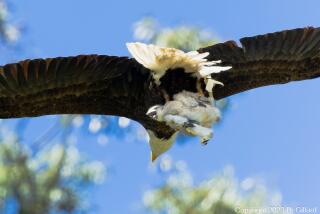National Bird Once Hated, Hunted for Bounty : Alaska Town Hopes to Feather Its Nest Promoting Bald Eagles
- Share via
HAINES, Alaska — Hunters here used to shoot bald eagles for a bounty of $2 each, and local emotion still ran against the national symbol four years ago, when the state designated an eagle sanctuary on logging and mining land.
Today the timber mills are closed, mine production is marginal and the town is looking for an economic boost.
Haines is looking to the eagles, but this time, the payoff will come from keeping the birds alive.
“When the mills started going down, we started casting around, looking for things to help the economy, and the eagles are it,” said Dianne Halliwill, local chapter president of the town’s new American Bald Eagle Foundation.
Civic leaders dreamed up the idea of an eagle foundation five years ago, along with a plan to raise $2 million for research in the “valley of the eagles,” where 1,800 people share the Chilkat River banks with about 4,000 bald eagles.
Plan to Boost Tourism
Organizers hope the foundation’s work will bring flocks of tourists to see the birds, fill Haines hotels and ease social problems caused by unemployment that affected 11.6% of the area’s work force in October.
“We were having financial difficulty. We had no place to put people, no jobs,” said Dave Olerud, a sport shop owner and vice president of the foundation.
He kicked off the first fund-raising effort this fall and collected $6,800 in pledges, mostly from local people, along with free land use and building supplies for a research center.
It was more support than he expected from a town whose people have had no more reverence for eagles than city folk do for pigeons.
Although American bald eagles are protected as an endangered or threatened species in the lower states, they are plentiful in southeastern Alaska, where they have been less disturbed by people and pesticides.
Long Coastline, Plentiful Fish
Alaska’s long coastline and plentiful fish also help support the eagles. Indeed, competition for salmon once turned indifference toward the birds to hostility in this area, where commercial fishing is a major industry. Today, however, it is understood that most salmon eaten by eagles are spawning and already near death.
The animosity was cemented by the fight over the eagle preserve. The eagle became the sticking point between conservationists, who wanted the land set aside, and loggers and miners, who wanted it kept open to development.
“I think it was just a symbol of the philosophical differences,” said Karen Wallace, secretary of the foundation’s Haines chapter.
Attitudes change. “Some of the people who were most adamantly against the eagles are now in favor of this project,” said Halliwill of the research center.
Olerud said that once the research center is finished next spring, it will serve as a base from which scientists can study the Chilkat eagles and perhaps learn how to help protect them elsewhere. Only about 1,500 breeding pairs of bald eagles are known to survive in the lower 48 states.
The centerpiece of Olerud’s pitch is the Alaska Chilkat Bald Eagle Preserve, 48,000 acres of state park dedicated in 1982 as an undisturbed eagle habitat.
The eagles begin gathering in late summer around warm upwellings in the Chilkat River, where salmon can be found months after other rivers have frozen over. Most of the eagles stay the winter, then return to nests throughout southeastern Alaska and Washington.
By late fall, their square, black silhouettes can be seen by the dozens lining a single river-bank cottonwood. The eagles ignore log trucks, cars and camera-toting bird watchers and stare away, in a haughty likeness to the symbols on coins and the federal seal.
On the river’s broad mud flats, the semblance of nobility disappears. The eagles wade in the shallows, their white heads and tail feathers set in damp spikes. They bicker in metallic squawks.
What is to be studied is something the foundation has yet to figure out. The group is proceeding on the premise that with so many birds here, there must be something to learn from them.
Scientists might look at the impact humans are having on them, why some eagles fail to raise young, or how much food is needed to sustain the eagle population, said Mike Jacobson of the federal eagle management in Juneau. His office, part of the U.S. Fish and Wildlife Service, would have to approve any eagle research project.
“If money was available, there’d be a whole lot of interest,” Jacobson said.
The eagle boosterism has both surprised and encouraged wildlife managers.
“Just from the history of Haines, I think it’s pretty interesting the turnaround people there have had in their attitude toward eagles,” Jacobson said. “It’s a complete flip-flop.”
More than 128,000 eagles were taken for territorial bounties of $1 or $2 a head between 1917 and 1953, and much of the hunting was done near Haines.
Shooting Continued
By the 1940s, eagle numbers had fallen to half the 30,000 that Alaska has today, and Jacobson said that the shooting went on even after a federal law protecting them was extended to Alaska in 1959. (Killing an American bald eagle can bring penalties of a year in jail and a $5,000 fine for the first offense.)
“After the bounty was done away with, there was still that mental attitude that a lot of people had--that eagles are bad, and you’re doing people a service to blow them away,” Jacobson said.
Now nearly everyone in Haines professes to like the eagles.
The town’s tourism director, Chip Waterbury, sends a man in an eagle costume to flutter on the dock when cruise ships call. The local radio station sells $2 “Chilkat Eagle” pins, and promotional pamphlets tout eagle-watching opportunities.
Even though most of Haines’ 62,000 annual visitors arrive in the summer and the eagles arrive in the off season, tourists can see enough of the birds to make them happy, Waterbury said.
Cruise Ships Bring Tourists
Haines lies at the northern end of Alaska’s Inside Passage waterway, and about half the tourists arrive on state ferries. Many of them pick up the Haines Highway that leads to the interior and Anchorage, 700 road miles to the northwest. Cruise ships bring most of the other visitors.
The potential to attract waves of bird lovers delights Olerud, but worries wildlife officials.
The preserve is a wilderness with one road: the two-lane Haines Highway, with its five unpaved pull-offs.
“We realize there’s a lot of people up on the highway with tripods and cameras, and that’s a problem. It’s dangerous,” said state park ranger Terry Rader.
“The ferry comes in, and 27 cars take off up the valley. Then there’s 25 eagles off to the side, and--’Gosh, Mom!’ ” he said, twirling an imaginary steering wheel out of control.
Trails and lookouts are needed, he said, but money appropriated for them evaporated this year with Alaska’s oil-based state budget.
More to Read
Sign up for Essential California
The most important California stories and recommendations in your inbox every morning.
You may occasionally receive promotional content from the Los Angeles Times.













